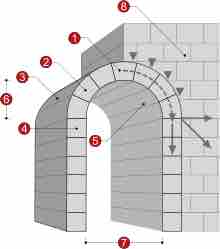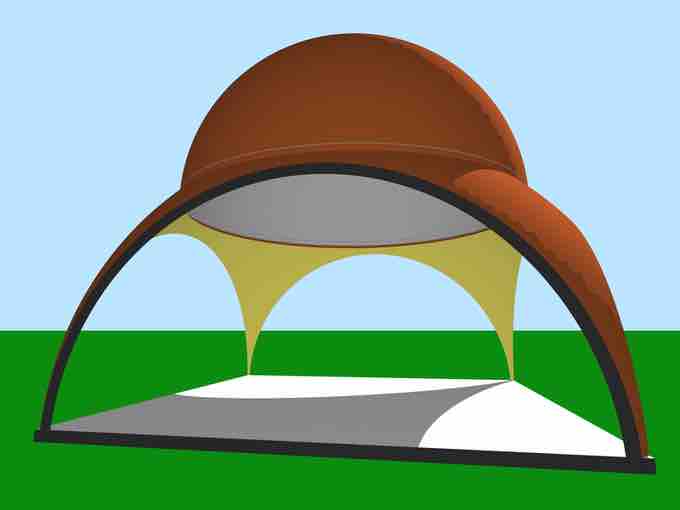Arches and domes are structures that exhibit structural strength and can span large areas with no intermediate supports. In this atom, we will discuss the history and physics behind arches and domes.
Arches
An arch is a structure that spans a space, and supports structure and weight above it. Arches have been being built from as long ago as the second millennium, but were not used for a variety of structures until the Romans took advantage of their capabilities. Arches are a pure compression form. They span large areas by resolving forces into compressive stresses and eliminating tensile stresses (referred to as arch action). As the forces in an arch are carried toward the ground, the arch will push outward at the base (called thrust). As the height of the arch decreases, the outward thrust increases. To prevent the arch from collapsing, the thrust needs to be restrained, either with internal ties or external bracing. This external bracing is often called an abutment, as shown in .

Arches
A masonry arch1. Keystone 2. Voussoir 3. Extrados 4. Impost 5. Intrados 6. Rise 7. Clear span 8. Abutment
The most common true arch configurations are the fixed arch, the two-hinged arch and the three-hinged arch. The fixed arch is most often used in reinforced concrete bridge and tunnel construction, where the spans are short. Because it is subject to additional internal stress caused by thermal expansion and contraction, this type of arch is considered to be statically indeterminate. The two-hinged arch is most often used to bridge long spans. This type of arch has pinned connections at the base. Unlike the fixed arch, the pinned base is able to rotate, allowing the structure to move freely and compensate for the thermal expansion and contraction caused by changes in outdoor temperature. Because the structure is pinned between the two base connections, which can result in additional stresses, the two-hinged arch is also statically indeterminate, although not to the degree of the fixed arch.
Domes
A dome is an element of architecture that resembles the hollow upper half of a sphere. Dome structures made of various materials (from mud to stone, wood, brick, concrete, metal, glass and plastic) and have a long architectural lineage extending into prehistory.
A dome is basically an arch that has been rotated around its central vertical axis. Domes have the same properties and capabilities of arches, they can span large areas without intermediate supports and have a great deal of structural strength. When the base of a dome is not the same shape as its supporting walls, for example when a circular dome is on a square structure, techniques are employed to transition between the two. Pendentives are triangular sections of a sphere used to transition from the flat surfaces of supporting walls to the round base of a dome.
Domes can be divided into two kinds, simple and compound. Simple domes use pendentives that are part of the same sphere as the dome itself. Compound domes are part of the structure of a large sphere below that of the dome itself, forming a circular base, as shown in .

Compound Dome
A compound dome (red) with pendentives (yellow) from a sphere of greater radius than the dome.